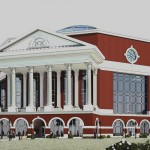Austin Ramsey
News Editor
Chris Wilcox
Staff writer

President Randy Dunn is considering a possible measure to pay for a new library projected to break ground some time between 2012 and 2014.
The measure, which Dunn announced Tuesday at the Murray State University Campus-Wide Administrators’ Meeting, would be to initiate a bond sale paid for by additional student fees.
Dunn said the completion of the Science Complex on N. 16th Street is still No. 1 on the capital projects list but the University was exploring several payment options for a planned library.
“We are looking at alternative revenues to possibly allocate for a new library,” he said.
Dunn said he had begun talks with the Student Government Association to discuss developing the revenue by means of student fees, adhering to a Council on Postsecondary Education policy stipulating possible fees must go before all students through a primary action vote.
Dunn said the idea was still on the drawing board and was one of many viable annuity options.
Tony James, associate bursar, whose office is responsible for the collection of such fees, said the president had not formally introduced the possible measure to that office.
“Sometimes, when you see plans like that (the administration) asks you to do calculations for cost, but they haven’t asked us to do that yet,” he said.
SGA President Jeremiah Johnson confirmed primary discussions were underway, but that no official details for the plan had been established.
“This is pretty new to everybody,” Johnson said.
He said no formal decision on the part of the SGA body has been made, but he and his executive body will meet soon to discuss the plan before presenting it to the senate.
“(Dunn) is going to come to a town hall or senate meeting and the senate will decide if we want to take that to the student body,” he said.
Johnson said a payment plan with bonds covered by student fees was also used to pay for the Bauernfeind Student Recreation and Wellness Center.
In that project, he said, the fees were raised but were never removed from the students’ bills after completion of the project.
Tom Denton, vice president of finance and administrative services, said while the Wellness Center project is complete, the bonds themselves have not reached optimal maturity. The payment process cannot begin until they have.
“The Wellness Center is still being paid for with the bonds so at the time the bonds are paid off – which will be years from now – the fees will be taken off,” he said.
While the Wellness Center project payment plan is similar to the one of which Dunn is in talks with the SGA, Denton noted some possible differences.
The University went into an agreement with the city of Murray to pay for the Wellness Center. The city issued agency bonds for which Murray State reciprocated through student fee-funded payments, Denton said.
That project, completed in 2004, cost the University $10.7 million. The average fee for students was $3 per credit hour. According to the 2008-10 budget of projects involving general funds, the library is slated to cost $48 million, nearly four times more than the Wellness Center project.
Beginning in December of 2002, those bonds will mature by June 1, 2033, according to the University’s audited financial statements for fiscal year 2010. At that point, Denton said the University will remove the cost in student fees.
Adam Murray, dean of University libraries, said the new building will house student service centers currently scattered across Murray State’s campus.
“The idea of a new library is to act as a learning commons – a facility to house and make academic services seemingly integrated,” he said.
Murray said the existing Waterfield Library will act as an administrative student support center.
In a description of floor plans and services document, the new library is expected to include the written and oral communication centers, an honors suite, a map room and a center for technology in learning and teaching classroom and conference room.
All special collections, genealogy and local history collections along with University archives, which currently exist in Pogue Library, will be moved to the new library as well.
It will also house several computer labs, a research analysis lab, two public verandas and a dining area accessible outside the library, seating more than 50 people.
Contact Ramsey
Contact Wilcox